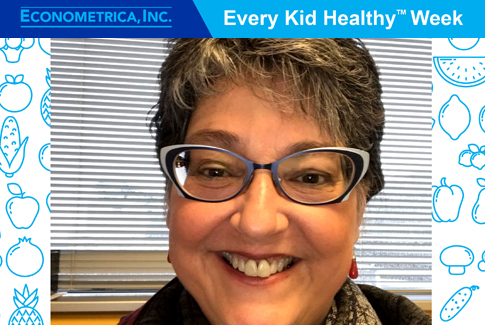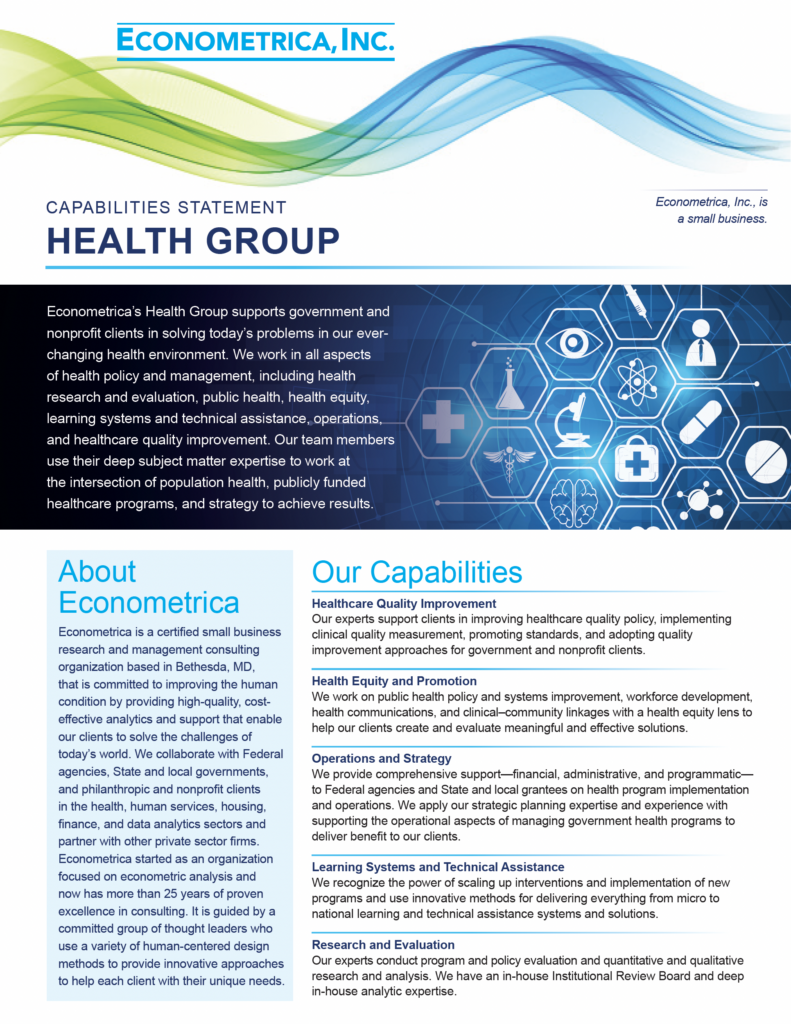 BETHESDA, MD – To celebrate today’s Tasty Tuesday for Every Kid Healthy Week, we interviewed a pediatric Registered Dietitian. Carol
BETHESDA, MD – To celebrate today’s Tasty Tuesday for Every Kid Healthy Week, we interviewed a pediatric Registered Dietitian. Carol
Henderson, a member of Econometrica’s Health Group, is a pediatrics Registered Dietitian who has worked with children and teens and their families for dozens of years. In particular, she worked with infants and children with feeding and growth issues and children diagnosed with chronic conditions and diseases, such as cystic fibrosis, diabetes, juvenile arthritis, gastrointestinal disorders, and severe food allergies.
Interviewer: I wonder if you could tell us a little bit about what it is like working as a pediatric dietitian and what you want to accomplish when working with children and their families?
Carol: The primary goal when working as a dietitian with pediatric patients who are sick is to ensure adequate, proportional growth throughout childhood. Some children need to grow bigger and become stronger and some need to minimize their growth over time. Pediatric dietitians also evaluate a child’s activity level, daily schedule, parent/caregiver roles, timing of meals and mealtime environment, food availability, meal preparation, and sleep patterns to gauge an individual’s nutritional needs. These actions align with each of the daily themes we are celebrating during Every Kid Healthy Week:
- Mindfulness Monday. Preparing healthy meals for a family is an investment that not only requires time, commitment, but also a state of mindfulness—a sense of calm that is needed to prepare meals, even during chaotic family times. Taking time out once a week to inventory foods on hand and create a shopping list may make it easier to put meals on the table.
- Tasty Tuesday. Today, which is Nutrition and Healthy Eating day, is a good time to assess the nutritional quality of the snacks your child/children are eating and how often they snack throughout the day. It is important to develop healthy feeding habits (have set times for meal and snack intervals—especially for young children) so they can achieve their nutritional intake goals every day.
- Earth Day Wellness Wednesday. Have you every quizzed your child to see where they think different food ingredients come from? This activity can turn into a project. You can select an ingredient in a dish you are preparing and ask if it comes from an animal, plant, or is it a mineral and go from there!
- Thoughtful Thursday. Kids react to their environment and learn from others. Therefore, creating a pleasant environment where your child can sit and eat meals at regular intervals and interact with other family members contributes to their social and physical well-being.
- Fitness Friday. Kids wiggle, squirm, run, and love to play—all things that contribute to their development. It is your job as parents/caregivers to find outlets for children to keep them active.
Interviewer: How did you pick dietetics as a profession?
Carol: Dietetics found me! I was going to become a high school chemistry teacher. In college, I conducted my junior year teaching practicum in a local high school. A small group of students in one chemistry class thought it would be hilarious to capitalize on my untested teaching skills, so they combined all the reagents (acids and bases) that lined the lab benches and blew up the chem lab. Everyone evacuated safely and I stood in the middle of the chem lab while the sprinklers were raining down on me and said, “I don’t ever want to be a chemistry teacher!” Because chemistry is such an integral part of food science and dietetics, I found a new calling.
Interviewer: There are so many different paths you could have undertaken with a dietetics degree, why pediatrics?
Carol: My oldest sister had just completed medical school and she received her residency “match” at Cincinnati Children’s Hospital. At the same time, I completed my Dietetic Internship at the Mayo Clinic in Minnesota, so we moved in together. A dietitian position opened at Cincinnati Children’s and I became one of two dietitians for a 750-bed hospital. That would not happen today. Nowadays, a children’s hospital of the same size would have more than 35 dietetic staff members. It has been a great blessing to have worked with children, teens, and their families as a pediatric dietitian and patient advocate for many decades.
Interviewer: Carol, do you have any parting thoughts you would like to share today?
Carol: The greatest gift I have received from working as a pediatric dietitian is the importance of play. Play consumes all children. I think as adults we should consume more play in our lives!
Interview edited for length and clarity. Thanks to Emma Wellington for conducting this interview.
About Econometrica:
Founded in 1998, Econometrica is a research and management organization in Bethesda, MD, established to provide public- and private-sector clients with customized program support services. Econometrica works with multiple agencies to provide high-quality, cost-effective analyses, modeling, and economic evaluations. The company consistently receives exceptional scores from its clients and believes in three principles: technical capabilities, happy customers, and business development.



 A recent study coauthored by Econometrica’s Health Director, Dr. Kristie McNealy, found that there is widespread support among researchers for efforts that attempt to reduce health disparities by using a multilevel approach to address the social conditions that help drive those disparities.
A recent study coauthored by Econometrica’s Health Director, Dr. Kristie McNealy, found that there is widespread support among researchers for efforts that attempt to reduce health disparities by using a multilevel approach to address the social conditions that help drive those disparities.







